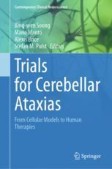Search
Search Results
-
Altered cerebellar volumes and intrinsic cerebellar networks in patients with transient global amnesia
This study aimed to investigate the differences in cerebellar volumes and intrinsic cerebellar networks between patients with transient global...

-
Cerebro-Cerebellar Networks
Considering the cerebellum an independent structure devoted mainly to motor control functions, neuroscience research has, until now, considerably...
-
Cerebellar Stimulation
Non-invasive brain stimulation (NIBS), encompassing Transcranial Magnetic Stimulation (TMS) and Transcranial Direct Current Stimulation (tDCS), is...
-
Cerebellar Reserve
The cerebellum can self-compensate and restore tissue damage in response to pathological injury, a unique property known as cerebellar reserve....
-
Cerebellar Developmental Disorders and Cerebellar Nuclei
While significant progress has been made in the last 10 years in understanding the development of cerebellar nuclei, they remain a relatively less...
-
Cerebellar Transcranial Magnetic Stimulation in Cerebellar Ataxias
Treatment options for autosomal dominant cerebellar ataxias are still scarce. Transcranial magnetic stimulation (TMS), a neuromodulation technique...
-
Cerebro-cerebellar motor networks in clinical subtypes of Parkinson’s disease
Parkinson’s disease (PD) patients can be classified in tremor-dominant (TD) and postural-instability-and-gait-disorder (PIGD) motor subtypes. PIGD...

-
Cerebellar Neurogenesis
The mechanisms of cerebellar neurogenesis have been redefined in the last few years, showing the precise spatiotemporal sequence of neuronal...
-
Activity map of a cortico-cerebellar loop underlying motor planning
The neocortex and cerebellum interact to mediate cognitive functions. It remains unknown how the two structures organize into functional networks to...

-
Cerebellar Closed Loops
Data from histological tracing studies in non-human primate strongly support the view that the cerebellar system is organized into distinct, motor...
-
Analysis of Gene Networks in Cerebellar Development
The purpose of this chapter is to provide a brief overview of the major gene networks that control cerebellum development. To simplify this task, all...
-
Differences in Olivo-Cerebellar Circuit and Cerebellar Network Connectivity in Essential Tremor: a Resting State fMRI Study
The olivo-cerebellar circuit is thought to play a crucial role in the pathophysiology of essential tremor (ET). Whether olivo-cerebellar circuit...

-
Cerebellar Physiology
The cerebellum is typically associated with motor control although there is now extensive evidence that its involvement extends into other domains...
-
Convolutional Neural Network for Fully Automated Cerebellar Volumetry in Children in Comparison to Manual Segmentation and Developmental Trajectory of Cerebellar Volumes
The purpose of this study was to develop a fully automated and reliable volumetry of the cerebellum of children during infancy and childhood using...

-
Distributed Plasticity in the Cerebellar Circuit
In contrast with the original Motor Learning Theory that included a single form of plasticity at the parallel fiber—Purkinje cell synapse, recent...
-
Cerebellar Neurostimulation for Boosting Social and Affective Functions: Implications for the Rehabilitation of Hereditary Ataxia Patients
Beyond motor deficits, spinocerebellar ataxia (SCA) patients also suffer cognitive decline and show socio-affective difficulties, negatively...

-
Cerebellar Agenesis
Cerebellar agenesis is an extremely rare condition in which patients show minute cerebellar tissue, usually corresponding to remnants of the lower...
-
Cerebellar tDCS as Therapy for Cerebellar Ataxias
In recent years, a growing body of literature has investigated the use of non-invasive brain stimulation (NIBS) techniques to influence cerebellar...
-
The Three Cornerstones of the Cerebellar Syndrome
The field of clinical ataxiology encompasses three main domains: the vestibulo-cerebellar syndrome (VCS), the cerebellar motor syndrome (CMS), and...
-
Cerebellar Heterotopia: Broadening the Neuroradiological Spectrum of KBG Syndrome
KBG syndrome is a rare genetic disorder caused by heterozygous pathogenic variants in ANKRD11 . Affected individuals have developmental delay, short...

